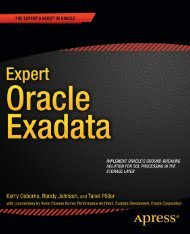Cisco MDS 9000 Family Switch-to-Switch Interoperability ...
Cisco MDS 9000 Family Switch-to-Switch Interoperability ...
Cisco MDS 9000 Family Switch-to-Switch Interoperability ...
Create successful ePaper yourself
Turn your PDF publications into a flip-book with our unique Google optimized e-Paper software.
Fibre Channel Features Affected by <strong>Interoperability</strong><br />
Chapter 1<br />
<strong>Interoperability</strong> Overview<br />
Send documentation comments <strong>to</strong> mdsfeedback-doc@cisco.com<br />
• Interop Mode 2 —This mode, also known as legacy switch interop mode 2, allows seamless<br />
integration with specific Brocade switches running in their own native mode of operation. Brocade<br />
switches must be configured with “core pid = 0” <strong>to</strong> work with this mode. See Chapter 7, “<strong>MDS</strong> <strong>9000</strong><br />
Legacy <strong>Switch</strong> Interop Mode 2”.<br />
• Interop Mode 3—Similar <strong>to</strong> interop mode 2, interoperability mode 3 was introduced for Brocade<br />
switches that contained more than 16 ports. With this VSAN-based interop mode, Brocade switches<br />
will not have <strong>to</strong> be altered from their native mode (core pid = 1) and can be seamlessly added <strong>to</strong> a<br />
new or existing <strong>MDS</strong> SAN-OS VSAN. This mode is also known as legacy switch interop mode 3.<br />
See Chapter 8, “<strong>MDS</strong> <strong>9000</strong> Legacy <strong>Switch</strong> Interop Mode 3”.<br />
• Interop Mode 4— This mode, also known as legacy switch interop mode 4, provides seamless<br />
integration between <strong>MDS</strong> VSANs and McData switches running in McData Fabric 1.0 interop<br />
mode. See Chapter 9, “<strong>MDS</strong> <strong>9000</strong> Legacy <strong>Switch</strong> Interop Mode 4”.<br />
IVR<br />
Inter-VSAN routing (IVR) allows a device that is located in one VSAN <strong>to</strong> communicate with a device<br />
that is located in another VSAN. IVR supports routing between all interop mode VSANs.<br />
Firmware Version Requirements<br />
The following switches have been tested with the <strong>Cisco</strong> <strong>MDS</strong> 9513, <strong>MDS</strong> 9509, <strong>MDS</strong> 9506, <strong>MDS</strong> 9216,<br />
<strong>MDS</strong> 9216i, <strong>MDS</strong> 9140, and <strong>MDS</strong> 9120 for interoperability:<br />
• Brocade 2400, 2800, 3200, 3800, 3900, and 12000<br />
• McData 3032 and 6064<br />
• IBM BladeCenter<br />
The following are minimum <strong>Cisco</strong> <strong>MDS</strong> SAN-OS versions for interop mode support:<br />
• Release 1.0(1)+ (standard interop mode, 1)<br />
• Release 1.2(1)+ (legacy switch interop mode 2)<br />
• Release 1.3(2a)+ (legacy switch interop mode 3)<br />
• Release 1.3(4a)+ (IVR with all interop modes)<br />
• Release 2.1(2b) (<strong>MDS</strong> 9020 support)<br />
• Release 3.0(1) (legacy switch interop mode 4)<br />
Note<br />
Refer <strong>to</strong> the <strong>Cisco</strong> <strong>MDS</strong> <strong>9000</strong> <strong>Family</strong> <strong>Interoperability</strong> Support Matrix for current firmware version<br />
support.<br />
Fibre Channel Features Affected by <strong>Interoperability</strong><br />
Each vendor (<strong>Cisco</strong>, McData, and Brocade) has its own native mode and an equivalent interoperability<br />
mode, which has the purpose of turning off specific advanced or proprietary features and providing the<br />
product with a more standards-compliant implementation.<br />
1-2<br />
<strong>Cisco</strong> <strong>MDS</strong> <strong>9000</strong> <strong>Family</strong> <strong>Switch</strong>-<strong>to</strong>-<strong>Switch</strong> <strong>Interoperability</strong> Configuration Guide<br />
OL-8400-02











